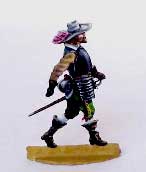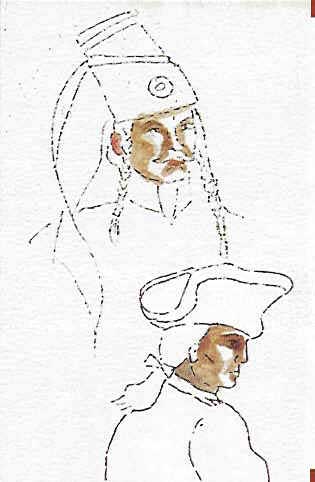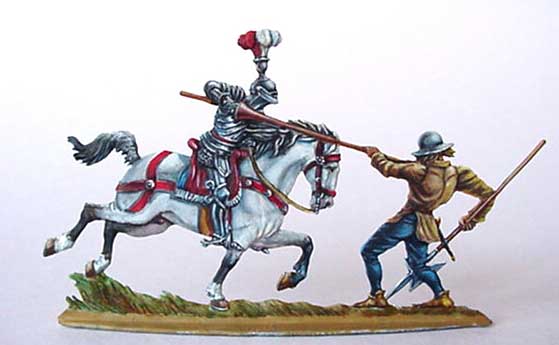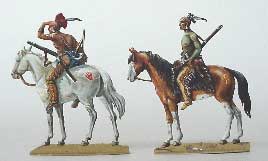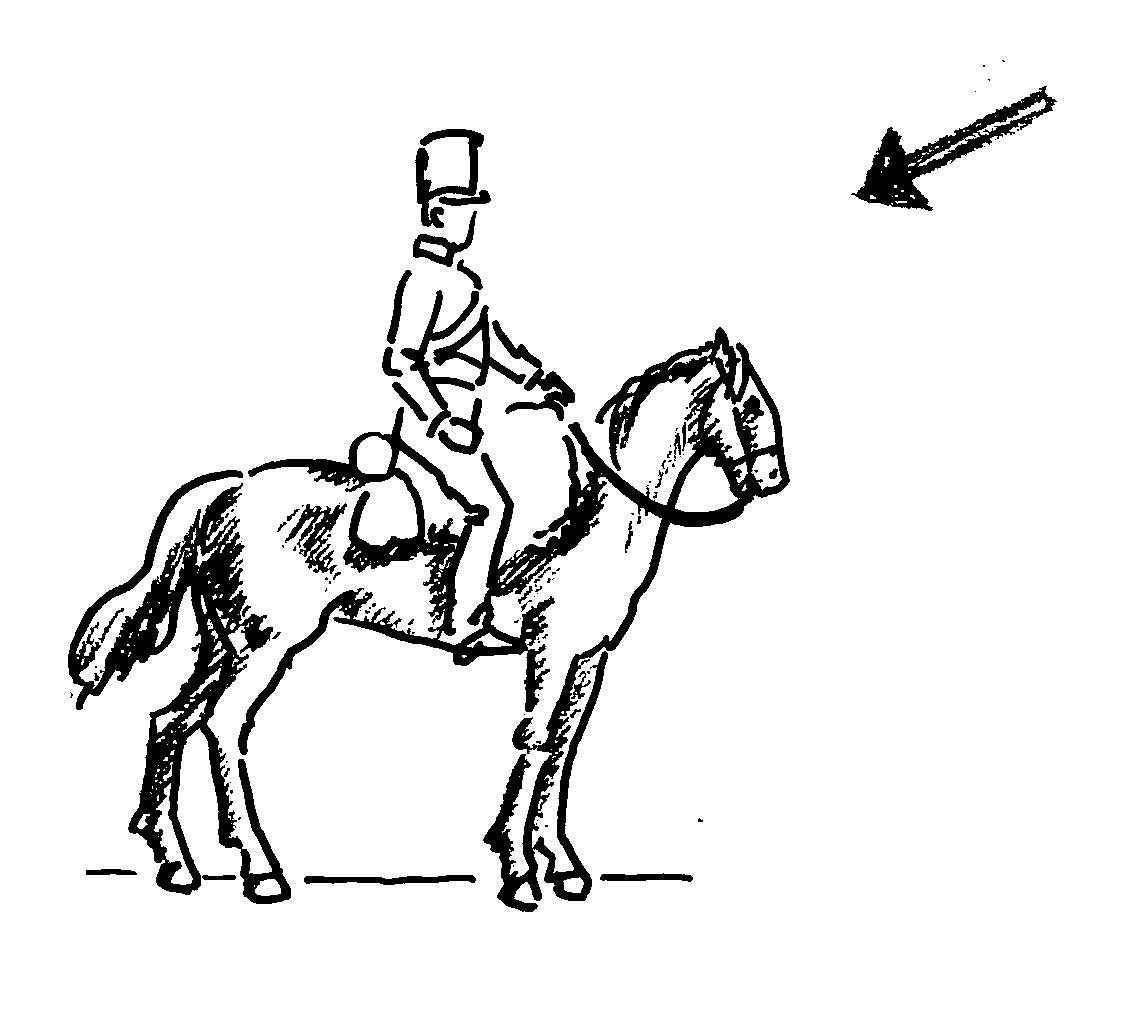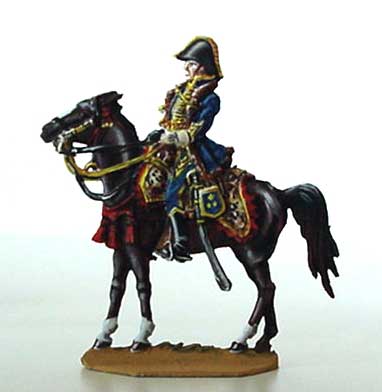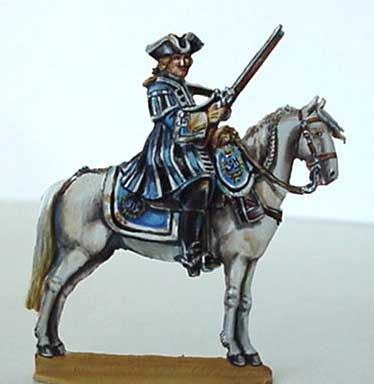PICCOLO CORSO PRATICO DI PITTURA
A SHORT PRACTICAL PAINTING COURSE
FOR FLAT FIGURES
|
Vorrei fare una premessa importante: qui cercherò di esporre la mia esperienza ed il mio modo di procedere, nell'intento di rendere più facile a chi legge, l'hobby di dipingere figurini piatti. Tuttavia vorrei sottolineare che in questa attività, come in altre attività creative, non ci sono nè obblighi, nè divieti, nè regole fisse ed ognuno può (e deve) seguire la via che ritiene più gratificante per se stesso, con lo scopo di ottenere un risultato per lui soddisfacente, anche se non viene subito confortato dal plauso di amici o dal successo ai concorsi. |
I would like to make a important preamble: here I would try to explain my experience and my approach to the hobby of flat figures painting, in order to make the hobby of this special kind of painting easier for the readers . However, I would state that in this matter, as in other creative activities, there are no obligations, no bans, no fixed rules and everyone can (and should) follow the path that feels more rewarding for himself, with the aim of obtaining a satisfactory result for him, even if not immediately comforted by the applause of friends or success at competitions.
|
|
Posto di lavoro ed attrezzatura Il posto di lavoro ha una sua importanza. Non serve tanto spazio (altro vantaggio dei piatti), basta un tavolino, però l'ideale sarebbe poter disporre di un angolo da lasciare sempre attrezzato in modo da dedicare all'hobby anche i ritagli di tempo senza dover ogni volta tirare fuori materiali, colori pennelli, ecc. L'attrezzatura
necessaria, probabilmente già in possesso di chi fa soldatini non
piatti, consiste in a) Utensili
per preparazione e fondo: Ultima fase
della preparazione: vernice di fondo. Si può applicare una o
due mani (leggere, per non cancellare i dettagli dell'incisione) di
smalto opaco bianco tipo Humbrol, oppure
(meglio e più veloce) si può usare una bomboletta spray di smalto
opaco bianco .
|
Workplace and tools
Since this is a basic course, let's speak briefly of what comes
before painting: the workplace and the equipment.
The necessary equipment, probably already in your possession if you
deal with figure painting, consists of:
This preparatory work should be done with care because, given the
small scale, a little defect on the piece will always appear
evident, unless you are able to mask it with a skillful painting.
|
|
b) Supporto Anche se
conosco alcuni piattisti che dipingono
il pezzo tenendolo sul palmo della mano, di solito è più comodo
mettere la figura su un supporto ed avere entrambe le mani libere.
In particolare, la seconda mano può servire come appoggio ulteriore
al pennello per dettagli particolarmente piccoli e precisi.
|
|
b) Support |
|
c) Colori,diluente
e pennelli
Come colori,
personalmente preferisco quelli ad olio per la facilità delle
sfumature e la sovrapponibilità dei colori,
nonchè per la possibilità poter realizzare in ogni caso
superfici di colore leggere e particolari abbastanza dettagliati. Non sono molti
come vedete; d'altra parte ho constatato che altri colori,
acquistati a suo tempo sull'onda dell'entusiasmo, sono rimasti
inutizzati. Un aspetto
molto importante nell'uso degli oli per i piatti e che mi ha dato
molti problemi all'inizio, riguarda il diluente:
infatti se si usa essenza di trementina o
i normali diluenti , ci si ritrova con colori lucidi, che nella
piccola scala dei piatti danno una apparenza "toy"
per niente soddisfacente. Come detto, l'essenza di petrolio non dà grande scorrevolezza al colore: per poter eseguire dettagli piccoli si può usare l'essenza di trementina; da non usare tuttavia su superfici estese, perchè, come detto, dà una finitura lucida. Ed ora un consiglio importante: è molto utile e più veloce, specialmente per le parti estese (es: manto dei cavalli) , dipingere prima le varie zone con colori acrilici come fondo e poi rifinire con i colori ad olio: infatti se si usano solo colori ad olio, si rischia di fare stesure spesse su cui si vedono i segni delle pennellate e difficili da gestire. Dato che gli acrilici asciugano subito, il poco tempo impiegato in più verrà largamente compensato da un lavoro successivo velocissimo. Pennelli: anche qui, consiglio di non tirare al risparmio, perchè un buon pennello facilita di molto il lavoro. Personalmente, uso pennelli Winsor & Newton , serie 7, triplo 0 e doppio 0, a punta corta. Per la vernice di fondo (chi non usa lo spray) usare un pennello o pennellessa morbida, ovviamente di dimensioni maggiori. Come tavolozza su cui porre e mischiare i colori, non consiglio quelle da pittore in legno che ritengo poco pratiche. Sono invece utili le tavolozze formate da fogli sovrapposti usa-e-getta (negozi di belle arti). Ultimo
attrezzo, ma sicuramente il più importante, è una buona vista! E' anche importante scegliere una illuminazione adatta, a luce bianca ed evitando lampade ad alta potenza (tipo alogeni o ad incandescenza) per non avere vicino agli occhi una fonte di calore e di irradiazione. Per completare, è ovvio che servirà una opportuna documentazione di riferimento (libri, riviste, ecc), specialmente per chi si dedicherà ai figurini militari piuttosto che ai civili o fantasy. Naturalmente, ora anche dal web si ottengono buone informazioni.
|
c)
Colours, thinner and brushes
The colors I use are listed below (with Winsor & Newton code):
Not many as you can see; on the other hand, I have found that other
colors, bought on the wave of enthusiasm, remained unused.
A very important feature in the use of oils for the flats and which
gave me many problems at first, concerns the thinner,
because, if you use turpentine or standard paint thinner, you will
have a shining finish, which, in the small scale,
give a glossy, unrealistic "toy" look.
As mentioned, the white spirit does not give smoothness to the oil colors: to carry out small details you can use turpentine, but not to be used on large areas because, as said before, it gives a glossy finish.
Brushes: here again, I suggest you do not try to spare money because a good brush makes your work easier and faster . Personally, I use Winsor & Newton brushes, Series 7, triple-0 and double-0, short tip for miniature.
For the base coat (if you do not use the spray) use a soft flat
brush, of course larger.
Palette:
As a palette on which to lay and mix colors, I do not recommend
those of wood for oil painters, because impractical and boring to
clean. You may use paper palettes, consisting of stacked throw-away
sheets (shops of fine arts). It is also important to choose a suitable lighting, white light and avoid high-power lamps (such as halogen or incandescent bulbs) for not having the eyes near a source of heat and radiation.
|
|
Pittura: generalità Abbiamo davanti
la figurina piatta, preparata e desolatamente bianca. In generale
comunque, bisogna stabilire da che parte proviene la luce che
illumina il soggetto e poi tenere sempre mentalmente in conto tale
decisione. In particolare, si può definire quali saranno le parti
più scure e quali le più chiare.
|
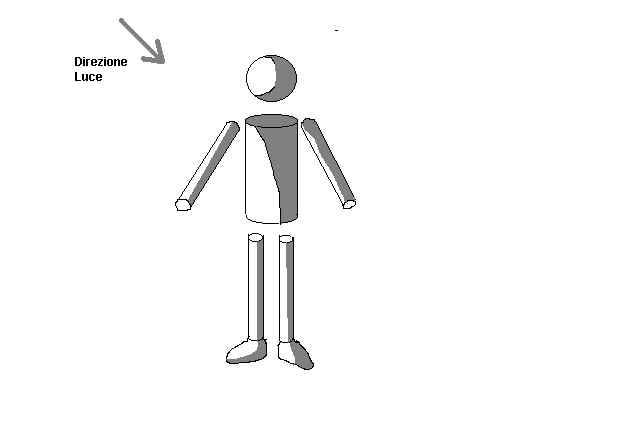 |
Painting: general
We are now ready at our painting station and we have in front the
flat figure, prepared and bleakly white.
I mean, you should try to imagine the figure as you would like to
see it when finished. This will be easy with a little of experience.
However, even with the application of the three tones, the result
may appear flat. In fact, in order to obtain realism, we need the
painting give the impression of roundness and depth: and therein
lies the fundamental difference with the all-round figures.
In general, we must decide from which side comes the light that
illuminates the subject and then keep in mind that decision. In
particular, we define what will be the darker and what
are the clearer areas.
|
|
Per facilitare la
comprensione di quanto sopra, proviamo a commentare un figurino già
dipinto per renderci conto dei vari problemi affrontati e delle
relative soluzioni proposte . |
|
In order to facilitate understanding of the above, let us comment about an already painted figure, to be aware of the various problems faced and solutions proposed. In this foot officer to the 30 years war , the figure receives the light from a source in the upper right: this is underlined by the shadows on the left side of the figure and blows of light on the armor. The shadow on the left leg gives depth to the painting. The shadow of the armor falling on the right leg suggests the separation of the metal surface from the leg itself.
|
|
Torniamo al
nostro pezzo preparato e cominciamo a dipingere, tenendo presente
che sarà difficile ottenere subito dei capolavori e che è
necessario, come in tutte le cose, "farci la mano". Dipingere sul
colore fresco o sull'asciutto? Con i colori ad olio si può
trarre vantaggio da entrambi i modi. Con certi
colori meno coprenti, se tentiamo di lavorare sul colore fresco
rischiamo di asportare la stesura precedente. Alcuni colori si presentano più trasparenti e gelatinosi (es.: terra di Siena bruciata, blu, verde, ecc): in questi casi risulta più veloce dare una prima passata con un colore acrilico (io uso Vallejo) che si asciuga subito e poi si aggiungono i colori ad olio. Sembra più complesso, ma il sistema permette di arrivare molto più rapidamente e senza pasticci al risultato finale; raccomandabile specialmente per i cavalli.
|
Let's come back to our prepared figure and let's begin to paint,
keeping in mind the difficulties of achieving masterpieces from the
start and that it is necessary, as in all things, to gain a bit of
experience.
This system has the advantage of offering at any time a glance in
order to maintain a general balance of tones, avoiding the figure
resulting as the sum of many details, perhaps well-painted
individually, but not tied together.
On the other hand, if we try to achieve details on the wet color, we
risk a mess because the colors tend to blend together. Example: If
you want to paint yellow laces on a still fresh blue background, the
result would be green laces, unless we deposit with the tip of the
brush a layer of fairly consistent color, with a light touch.
However,
sometimes you may have unpleasant side-effects: for example,
remember that white and black give grey,
and yellow more blue results in green, even if they are present only
as a little component in a certain mixture.
With some transparent colors, if we try to work on wet color, there
is the risk to remove the previous layer. Some colors are more transparent and gelatinous (e.g.:Burnt Sienna, Winsor blue, Winsor green, Magenta, violet, etc.): in these cases it is faster to give a first coat with an acrylic paint (that dries quickly and give a solid underlayer) and then add oil paint. It seems more complex, but the system allows you to arrive much more quickly and without troubles to the final result (especially recommended for horses).
|
|
Pittura: dettaglio Abbiamo il
pezzo pronto, preparato con la sua mano di fondo completamente
asciutto. Come molti figurinisti, anch'io preferisco cominciare dal viso, che è la parte che più dà vita al soggetto. Viso e pelle: uso Terra di Siena bruciata nelle zone in ombra, che sono : cavo degli occhi, sotto zigomi, lati del naso, zona sotto labbro inferiore e mento. Applico poi colpi di luce con bianco puro sugli zigomi, sul naso e sul mento, sfumando con il terra di Siena già applicato nelle zone di ombra. Sembrerà semplicistico, ma vi assicuro che dà risultati soddisfacenti.
|
|
Painting procedure:
Face and skin: I use Burnt Sienna in shadow areas, i.e.: around eyes, under the cheekbones, the sides of the nose, the area under the lower lip and chin. Then I apply light strokes of pure white on the cheekbones, nose and chin, blending with the Sienna just been applied in the shadows. It may seem simplicistic, but I assure you that it gives satisfactory results.
|
|
Volendo aumentare
il livello di finitura, si può procedere come segue. Per gli occhi è meglio lavorare sul secco: a volte (profilo), basta aggiungere una punta di bianco all'angolo esterno dell'occhio per avere l'effetto giusto. L'operazione si fa con un pennello con buona punta o anche applicando il colore con la punta di uno spillo. Se si sbaglia la posizione si può cancellare o correggere con il pennello inumidito di diluente. Per un occhio più dettagliato, si può aggiungere un punto scuro che rappresenta l'occhio: si allunga poi la parte superiore in una linea che rappresenta le ciglia con il pennello umido. Si possono poi aggiungere ai lati della pupilla punti di bianco appena sporcato di azzurro. Tutto ciò, lavorando con mano leggerissima e sfiorando il pezzo con il colore caricato sul pennello. Da evitare in ogni caso il punto nero da solo in mezzo alle occhiaie: piuttosto, meglio la sola zona di ombra senza ulteriori dettagli. Capelli, baffi, barbe: i colori che di solito si usano sono: nero, marrone, ocra, Terra di Siena bruciata + nero, rispettivamente per capelli neri, castani e biondi . Si schiarisce nelle zone in luce rispettivamente con azzurro, bianco+giallo, Terra di Siena + bianco, senza però sfumare, ma cercando di depositare leggere tracce di colore puro. Abiti
:
a parte la seta, tutti gli abiti dovrebbero presentare toni opachi:
l'effetto si ottiene con i tre toni già detti, con passaggi molto
sfumati da un tono all'altro. Per la seta invece si devono applicare
colpi di luce molto intensi lungo il sommo delle pieghe in luce.
|
Wanting to increase the level of finishing, you can proceed as
follows.
For a more detailed eye, you can add a dark dot that represents the
eye, extending with the wet brush the top of dot in a line that
represents the eyelashes . You can then
add at the sides of the pupil white points. All this, working with
very light hand . Hair, mustaches, beards: the colors that are generally used are: Black, brown, Ochre, Burnt Sienna + White, respectively, for blacks hair, brown and blond . Highlight areas respectively with blue, rose, white + yellow, burnt sienna + white, without shading, but trying to lay tracks of pure color.
|
|
Abiti blu scuro: uso Winsor blu con un po' di nero per il tono medio, il nero per le zone in ombra ed il Blu+bianco per le zone più illuminate. (Ufficiali Granducato di Toscana - figure Hafer) |
|
Dark blue clothes: I use Winsor blue with a bit of black for the middle tone, the black for areas in shadow and the blue + white for the most lightened parts.
|
|
Abiti rossi: come già accennato, è sconsigliabile applicare il bianco per il tono più chiaro: ciò darebbe solo l'effetto di un colore stinto dal sole o dall'usura. In pratica, si ottiene un buon risultato lasciando il rosso puro nelle zone in luce e ponendolo in contrasto con diversi toni di rosso scuro, ottenuti aggiungendo più o meno nero o blu. (figure: Maier)
|
|
Red dresses: as already mentioned, it is unadvisable to apply the white for lighter tone: this would only give the effect of a color faded from the sun or wear. In practice, you'll get a good result, leaving the pure red on light areas and placing it in contrast with several shades of dark red, obtained by adding more or less black or blue. (figures: Editor Maier) |
|
Vestiti bianchi:
il bianco si ombreggia non solo con il grigio, ma praticamente con
tutti i colori, con effetti diversi. Ad esempio pantaloni bianchi
ombreggiati con un tono arancio danno un effetto molto caldo;
ombreggiati con azzurro danno sempre l'idea del sole ma in ambiente
freddo; ombreggiati con tono giallo tenue danno
una impressione di vecchio, usato. (Fig: Bersaglieri Italiani in Africa -incisioni di prova del sottoscritto) |
|
White dresses:
for shadows on white, do not use only gray shades, but virtually all
colors, with different effects.
For example, white pants with a shaded orange tone give a very warm
effect, while a shading with blue gives
the idea of a cold shadow; shading with pale yellow tone gives the
impression of old, used. (Fig: Italian Bersaglieri in Africa - test engravings of the author) |
|
Tessuti neri:
se applicassimo come tono medio il nero, ci toglieremmo la
possibilità di scurire la zona in ombra: quindi io uso un marrone
molto scuro (terra di Siena bruciata+nero)
per il tono medio, terra di Siena+bianco
per le zone in luce e nero puro per le zone in ombra. Tessuti verdi: non uso mai il verde Winsor da solo, in quanto dà un effetto eccessivamente brillante ed innaturale. Aggiungo quindi un po' di terra di Siena bruciata, oppure nero, oppure Blu, a seconda dell'effetto desiderato. Zone in luce con giallo o bianco e zone in ombra con nero o Terra d'ombra (sempre opportunamente sfumate). Numeri,scritte, tratti fini: meglio lavorare su asciutto. Tenuto conto che l'essenza di petrolio che utilizziamo per avere pittura opaca non dà scorrevolezza al colore, dovendo fare tratti fini, è opportuno usare trementina e lavorare con un pennello triplo 0 , con mano leggerissima, praticamente sfiorando la superficie. In qualche caso, risulta più facile depositare dei puntini di colore e poi raccordarli con la punta del pennello. Le sbavature possono sempre essere eliminate con una rifilatura ottenuta con un altro pennello inumidito con diluente. Pellicce, colbacchi, pelli di montone: oltre alla solita tecnica dei tre toni, è molto efficace l'aggiunta di segni brevi e sottili che suggeriscano i peli della pelliccia. Per la pelliccia bruna: con colore rosato; per la pelliccia bianca o montone: in grigio-marrone; per le pellicce nere (colbacchi): in bianco azzurro. Per questi dettagli consiglio di caricare bene il pennello di colore ed usare delicatamente la punta a sfioramento. Un'altra tecnica per suggerire la consistenza del pelo consiste nel lavorare con una punta di spillo la vernice fresca (delicatamente, per non rovinare il fondo). Cuoio di stivali e cinghie lucide: per dare l'effetto del materiale lucido riservare o applicare una zona irregolare di bianco puro, sfumata agli estremi nel colore base. Per gli stivali neri lisci, dipingere una striscia verticale irregolare in bianco ed ai due lati nero o marrone. Poi sfumare le zone di confine. Sulle pieghe del cuoio dare colpi di luce in bianco puro , sfumato agli estremi.
Oro-metalli
dorati
: la
parte più in luce è bianco puro, sfumato nel giallo di cadmio, poi
giallo arancio (ossia aggiunta di una punta di rosso), fino a terra
di Siena bruciata per la parte in ombra. Se occorre un tono più
scuro per la parte in ombra si può usare terra d'ombra o anche nero.
|
Black
clothes :
if we use pure black as medium tone , we shall remove our
possibility to darken the area in shadow. Therefore I use a very
dark brown (burnt sienna + black) for the middle tone, sienna +
white areas in light and pure black for the shadow areas.
Numbers, letters, subtle lines: it is better to work on dry. Given that the white spirit we use for matt results does not give a fluent smooth color on the brush, for this detailed task turpentine should be used together with a triple 0 brush , with a light hand, almost touching the surface. In some cases, it is easier to deposit small dots of color and then join them with the brush tip. The burrs can always be removed with a trimming obtained with another brush moistened with solvent.
Furs, busbies, sheepskins:
in addition to the usual technique of three tones, it is very
effective to add signs to suggest short and thin hairs of the fur.
Gold-gilded metals:
the most lighted part is pure white, shading in cadmium yellow, then
orange and yellow (i.e.:, adding a touch
of red), up to burnt sienna to the parts in shadow. If you need a
darker tone to the part in shadow, you can use umber or black.
|
|
Acciaio lucido:
per la parte in luce: bianco puro, sfumato nel grigio fino a nero.
In generale, si possono usare come tono scuro
anzichè il nero, mescolanze a dare un tono marrone scuro o
blu scuro (sempre sfumato fino a bianco puro). Consiglio di
osservare riproduzioni di quadri per avere una visione più ampia: si
vedrà comunque che l'effetto metallico, più che dal colore generale,
è dato dalle aree bianche che suggeriscono il riflesso della luce da
parte della superficie lucida.
|
|
Polished steel:
the part in light: pure white, shading from gray to black. In
general for the dark tone, you may use brown instead of black, tone
mixtures to give a dark brown or dark blue (always fading to pure
white). I advice to look at reproductions of paintings to have a
more wide view:you
will see, however, that the metallic effect, rather than the general
color, is given by the white areas that suggest the reflection of
light from the shiny surface.
|
|
Argento nelle spalline o bordature: passando da luce ad ombra: bianco-grigio-nero; nella zona in ombra ci sta bene un po' di azzurro. Diversamente, la spallina o la bordatura, sembrano di colore bianco. Per tutti i metalli, a colori asciutti, è bene aggiungere nelle parti più in luce dei punti di bianco puro. Bottoni argento o oro: vengono più realistici nel seguente modo. Prima si depositano con la punta del pennello ben carico una serie di punti con una tinta di fondo (terra di Siena bruciata per l'oro e grigio-azzurro per l'argento); dopodichè sulla vernice asciutta si applica un puntino più piccolo di giallo cadmio per l'oro o bianco per l'argento. Ombreggiatura generale: quando si comincia ad avere la figura completamente dipinta anche se non finita, è meglio cominciare ad osservarla nel complesso per vedere se c'è la giusta profondità e rotondità. Considerata la direzione di provenienza della luce, non abbiate paura di caricare l'ombra sul lato opposto, anche se vi sembra in tal modo di coprire dei particolari. I particolari devono essere evidenti solo nelle zone ben illuminate e solo accennati nelle zone in ombra. Diversamente emergerà un effetto di piattezza, che è proprio quello che si vuole evitare.
|
Silver in the straps or laces: switching from light to shadow: white-gray-black. In the shadow area a bit of blue gives the right effect. Otherwise, the shoulderstrap or the lace, appear white.For all metals, on dry color, you should add dots of pure white in the highligh points.
Shadow General: When you begin to have the figure completely covered with colors even if not finished, it is useful beginning to observe it on the whole, in order to see if there is the right depth and roundness. Given the direction of the light, do not be afraid to load the shadow on the opposite side, even if it seems to cover the details. The details must be evident only in floodlit areas and only suggested in shadows. Otherwise an effect of flatness will emerge, which is exactly what we want to avoid.
|
|
Ombre riportate:
una spada, un cinturino o un guanto che pende possono proiettare
un'ombra sul corpo della figura. Le ombre riportate, se ben
realizzate, aumentano di molto la tridimensionalità del pezzo. Ciò
si ottiene dipingendo la forma dell'ombra con un tono scuro
dell'area dove l'ombra cade. (figure Maier)
|
|
Secondary shadows:
a sword, a belt or an hanging glove may
cast a shadow over the body of the figure or of the mounted horse.
These shadows, if well painted, greatly enhance the
three-dimensionality of the piece.This
is achieved by painting the shadow shape with a dark tone of the
area where the shadow falls. |
|
Pittura di cavalli ed altri animali (elefanti, cammelli, ecc) sui figurini piatti. Premessa: per quanto riguarda il colore del mantello dei cavalli , per semplicità (mi perdonino gli esperti di ippica), li chiamerò: cavallo bianco, marrone, nero anzichè albino, grigio, palomino, baio, sauro, ecc. Anche qui supponiamo di partire dal pezzo già preparato con il suo fondo di smalto bianco opaco. Prima decisione da prendere: scegliere il colore del cavallo. Teniamo presente che in alcuni casi la scelta è obbligata: per esempio per i trombettieri, che hanno sempre cavallo bianco o grigio. Anche certi reparti speciali hanno cavalli di un preciso colore, per esempio: Scots Greys Inglesi con cavallo bianco (in inglese: grey), da cui il nome. Fino a che non ci si fa la mano, è meglio partire avendo come modello una buona illustrazione o foto di un cavallo in una posizione simile a quella del figurino in lavorazione. In aggiunta, sarebbe bene procurarsi uno di quei quei libretti illustrati a colori sulle razze dei cavalli (ne esistono di diversi tipi, dal tascabile al libro da regalo): in tale modo, anche se le variabili e le combinazioni di colori nei cavalli sono quasi infinite, non si correrà il rischio di inventarsi qualche razza mai esistita.
|
Paintings of horses and other animals (elephants, camels, etc.) on flats. Preliminary remark: as for the color of horse manltles, for simplicity (I beg pardon to horse experts), I'll call them: the white, brown, black instead of albino, gray, palomino, bay, chestnut, etc
|
|
In generale: La figura illustra una distribuzione schematica di ombre e luci, con provenienza della luce come indicato. Le ombre vanno sempre sfumate ai contorni, in modo da evitare l'effetto "carta topografica".
|
|
In general:
The
figure shows the schematic distribution of lights and shadows, with
direction of light as indicated by the arrow. The shadows shall be
always shaded in order to avoid the geographic map effect.
|
|
Per quanto
riguarda la pittura, ho sperimentato un sistema molto semplice e
veloce per dipingere i cavalli , che
basicamente consiste nel deporre sulle varie parti i colori puri
(zone chiare e zone scure) in modo da avere una disposizione di
colore ad aree chiare e scure, senza minimamente considerare
dettagli piccoli come briglie e finimenti. Poi, con un pennello
vecchio (meglio a pelo corto), si sfuma nelle zone di confine tra le
aree fino ad avere passaggi morbidi da un tono all'altro. Su questo
fondo si aggiungeranno poi i particolari, le ombre, ecc E'
incredibile come funzioni bene questa tecnica semplice, che
oltretutto ha il pregio di dare subito una
idea complessiva di tutto il cavallo, evitando differenze di
toni tra una parte e l'altra, come invece può capitare spesso se si
procede per singole zone. Se occorre, si
possono rinforzare in seguito i toni più chiari
o più scuri .Poi si dipingono la sella, le briglie, le ombre
(v. avanti). |
|
As for painting, I experienced a very simple and quick way to paint
the horses, which basically consists in laying on different parts
the pure colors (light areas and dark areas) in order to have a
rough distribution of light and dark areas ,
without considering small details such as bridles and harnesses.
Then, with an old brush (preferably short-haired), blend the border
line between the areas until you have smooth transition from one
tone to another. On this painting base you will add the details,
shadows, etc. It 's amazing how well this simple technique works,
with the additional advantage of immediately having a comprehensive
idea of all the horse, avoiding differences in tone between a part
and the other , as it can often happen if you proceed per individual
zones.
If necessary, at a second stage, you can reinforce the tones lighter
or darker. Then paint saddle, bridles, shadows (see below). |
|
Tipi di manto: Cavallo bianco: Come già detto , le zone d'ombra del bianco basicamente si ottengono con vari toni di grigio, tenendo conto che il tono più scuro di solito è per la zampa posteriore interna. Il grigio si ottiene mescolando bianco e nero (non uso grigi già preparati come il grigio di Payne), magari con un po' di azzurro (Winsor blu+bianco, oppure Indigo+bianco) o rosa.
|
Horse Mantle types:
The gray is obtained by mixing black and white (do not use ready-made gray as the Payne gray), perhaps with a little blue (Winsor blue + white + black or Indigo) or rose.
|
|
Le sfumature si ottengono al solito deponendo il tono grigio nelle zone in ombra e bianco puro nelle zone da illuminare e poi sfumando nella zona intermedia. Tuttavia, se si lascia il pezzo solo con i toni di bianco e grigio si avrà un risultato abbastanza monotono e poco realistico: sarà opportuno arricchire con qualche tocco di rosa (zona della bocca, sottopancia e collo) e di azzurro ( qua e là alla fine di zone in ombra per dare più rotondità). Anche qualche accenno di marrone o di ocra non guastano. Ci sono cavalli bianchi con i garretti neri : questo nero si ottiene con una prima passata di nero abbastanza diluito e poi sovrapponendo piccole zone di azzurro bianco sulle parti in rilievo, con sfumatura ai contorni, ma avendo cura di lasciare il colore puro nella zona più in luce. Nero puro (sfumato ai contorni) nelle zone più in ombra. Gli zoccoli nei cavalli bianchi possono andare dal colore crema al marrone scuro, al grigio scuro: anche qui ci vuole un tono più chiaro nella zona in luce ed una zona più scura nella parte più nascosta. Non dimenticare di descrivere il ferro sotto lo zoccolo, aggiungendo una sottile linea bianca terminante in azzurro nella parte in ombra. Le zampe vanno considerate dal punto di vista pittorico come lunghi cilindri di cui tutta una parte risulta in leggera ombreggiatura (grigio azzurro). Code e criniere: per i cavalli bianchi possono andare dal bianco al bianco crema, al grigio più o meno scuro fino al nero. Sfumare accuratamente per dare l'dea della sofficità ed incosistenza del materiale. Colpi di luce (bianco puro) alla sommità della criniera e nella parte in luce della coda. Bisogna avere assolutamente bianco nelle zone in luce, p.es: muso, parte alta del collo, petto, parte superiore del posteriore. Eventualmente sovrapporre bianco, sfumando nelle zone di confine. |
|
The shades are usually obtained by depositing the tone of gray in shadows and pure white on the lihgted areas, with usual blending of tones. However, if you leave the figure only with shades of white and gray, the result may be quite monotonous and unrealistic: it will be enriched with a touch of pink (mouth area, and neck girth) and blue (around the end of shaded areas to give more roundness). Also some touches of brown or ocher may add more realism.l
There are white horses with black heels: this is achieved with a
first coat of black quite diluted, and then superimposing small
areas of white - blue on the parts in relief, but taking care to
leave the pure color in the most highligted
area. Pure Black (blended at the edges) in the darker parts.
|
|
Cavalli pomellati grigi : Oltre a quanto già detto per i manti bianchi, si aggiungono piccole macchie di grigio-marrone con la punta di un pennello vecchio usato come tamponcino. Ciò solo in alcune zone come muscoli pettorali, collo e posteriore. Senza esagerare nel numero e nel tono: basta suggerire l'idea. Sulle parti in luce picchiettare con un tono più chiaro. Cavallo crema "Palomino" : Uso come tono
medio una mescola a base di bianco con una punta di ocra, oppure di
terra di Siena bruciata, per dare un tono più caldo. Per le zone in
ombra : terra di Siena bruciata. Interno
zampa posteriore: marrone scuro (nero e rosso). Cavallo marrone: Si possono avere tutti i toni di marrone. Come tono chiaro si può andare dall'ocra, all'arancio al rossiccio. Per i toni scuri, dal terra di Siena bruciata al nero. Un buon marrone coprente si ottiene mischiando rosso+nero. Spesso i cavalli marrone hanno i garretti neri: vale quanto già detto sopra per i cavalli bianchi. Cavallo nero : Secondo me, è
quello più difficile da realizzare, per la necessità di riuscire ad
equilibrare il manto scuro con le zone colpite dalla luce che
riflettono molto ed assumono nella realtà toni
dall' azzurro chiaro al bianco puro;
bisogna riuscire a realizzarle evitando di mescolare
direttamente bianchi e neri che, come già detto, darebbero toni
grigi , assolutamente non realistici. Particolari comuni: Occhio del
cavallo: in nero puro, cercando di realizzare la vera forma
dell'occhio dell'animale in relazione alla posizione del muso; si
aggiunge poi, meglio a colore asciutto, una
piccolissima punto di bianco per dare il riflesso
dell'occhio. Selle: si trattano come il cuoio . In particolare , se è visibile il pomello della sella (anteriore o posteriore) un colpetto di bianco puro in cima dà il senso di lucido del cuoio. Pelli di montone bianche: usare bianco puro per la parte in luce e grigio-marrone per la parte in ombra, sovrapporre poi nella zona in ombra dei leggeri segni più chiari simulanti il pelo e diretti in varie direzioni. Si può anche usare uno spillo (molto delicatamente) come una matita che, spostando il colore fresco e rivelando il bianco del fondo dà lo stesso effetto. Pelli di montone nere: dall'ombra alla luce con tono da nero al grigio azzurro, anche qui accennando gruppi di peli con azzurro nelle zone in ombra e in nero nelle zone in chiaro. Come sempre, colpi di colore aggiuntivi per variare la monotonia di una superficie sono sempre di effetto. Ombre riportate
Sono le ombre
proiettate da oggetti esterni al cavallo stesso:
es: il cavaliere, spade, fucili,
briglie, sabretache, shabraques, ecc. Cammelli: Le tinte sono molto simili al cavallo beige (Palomino) con toni decisamente bianchi per le zampe ed il muso. Anche gli zoccoli hanno aspetto biancastro (polvere). Nessun colpo di luce, in quanto il manto deve risultare di tono opaco. Come esempio, si può vedere sul sito l'immagine delle truppe cammellate napoleoniche (Era Napoleonica) Elefanti Il tono
dominante è il grigio, con zone in ombra fortemente tendenti
all'azzurro-blu . Considerazioni finali per quanto riguarda la pittura: Come detto, quanto sopra deriva dalla mia esperienza di pittore di figurini piatti (nonchè di figurini 54 mm, nonchè di acquarelli): tuttavia, ripeto che questo è il campo della fantasia e dell'inventiva (per quanto riguarda la tecnica; non per la uniformologia!) e quindi non ci sono dogmi. Ognuno poi seguirà la tecnica che gli sembrerà più efficace. L'importante è avere un passatempo distensivo e piacevole. I principianti
non si scoraggino se quanto sopra sembra complicato e difficile. In
realtà non lo è: basta un po' di precisione ed un po' di costanza.
Buona pittura a tutti !
|
Dappled gray horses:
.
Black horse:
Details in common:
White sheepskin: use pure white for the part in light and gray and
brown for the part in shadow. You may then simulate the hair by
overpainting clear signs (directed in various directions) for the
shaded areas and darker signs for the highligh areas . You can also
use a pin (very gently) as a pencil, locally removing the fresh
color and revealing the white background.
Black sheepskin: from shadow to light tones use black to gray blue,
again suggesting groups of hair with white-blue in shadows and black
in the clear areas .
These
shadows, even if
only suggested,
give rich
effects of depth and
tri-dimensionality.
Elephants
Final considerations regarding the painting:
|

